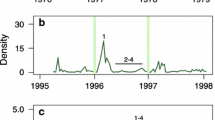Abstract
Climate change is likely to disrupt the timing of developmental events (phenology) in insect populations in which development time is largely determined by temperature. Shifting phenology puts insects at risk of being exposed to seasonal weather extremes during sensitive life stages and losing synchrony with biotic resources. Additionally, warming may result in loss of developmental synchronization within a population making it difficult to find mates or mount mass attacks against well-defended resources at low population densities. It is unknown whether genetic evolution of development time can occur rapidly enough to moderate these effects. We present a novel approach to modeling the evolution of phenology by allowing the parameters of a phenology model to evolve in response to selection on emergence time and density. We use the Laplace method to find asymptotic approximations for the temporal variation in mean phenotype and phenotypic variance arising in the evolution model that are used to characterize invariant distributions of the model under periodic temperatures at leading order. At these steady distributions the mean phenotype allows for parents and offspring to be oviposited at the same time of year in consecutive years. Numerical simulations show that populations evolve to these steady distributions under periodic temperatures. We consider an example of how the evolution model predicts populations will evolve in response to warming temperatures and shifting resource phenology.
Similar content being viewed by others
References
Allee, W., Emerson, A., Park, O., Schmidt, K., 1949. Principles of Animal Ecology. Saunders, Philadelphia.
Bentz, B.J., Logan, J.A., Amman, G.D., 1991. Temperature-dependent development of the mountain pine beetle (Coleoptera: Scolytidae) and simulation of its phenology. Can. Entomol. 123, 1083–094.
Bentz, B.J., Logan, J.A., Vandygriff, J., 2001. Latitudinal variation in Dendroctonus ponderosae (Coleoptera: Scolytidae) development time and adult size. Can. Entomol. 133, 375–87.
Berryman, A.A., Dennis, B., Raffa, K.F., Stenseth, N.C., 1985. Evolution of optimal group attack, with particular reference to bark beetles (Coleoptera: Scolytidae). Ecology 66(3), 898–03.
Bleistein, N., Handelsman, R.A., 1986. Asymptotic Expansion of Integrals. Dover, New York.
Calabrese, J.M., Fagan, W.F., 2004. Lost in time, lonely, and single: reproductive asynchrony and the Allee effect. Am. Nat. 164(1), 25–7.
Carroll, A., Taylor, S., Régnière, J., Safranyik, L., 2003. Effects of climate change on range expansion by the mountain pine beetle in British Columbia. In: Shore, T., Brooks, J., Stone, J. (Eds.), Mountain Pine Beetle Symposium: Challenges and Solutions. Information Report BC-X-399, pp. 223–32. Klowna, British Columbia, October 2003. Natural Resources Canada, Canadian Forest Service, Pacific Forestry Centre, Victoria.
Christensen, J.H., et al., 2007. Climate Change 2007: The Physical Science Basis. Contribution from Working Group I to the Fourth Assessment Report of the Intergovernmental Panel on Climate Change. Cambridge University Press, Cambridge.
Danks, H.V., 1987. Insect Dormancy: An Ecological Prospective. Monograph Series, vol. 1. Biological Survey of Canada (Terrestrial Arthropods), Ottawa.
de Bruijn, N.G., 1981. Asymptotic Methods in Analysis. Dover, New York.
Eubank, W., Atmar, J., Ellington, J., 1973. The significance and thermodynamics of fluctuating versus static thermal environments on Helios zea egg development rates. Environ. Entomol. 2(4), 491–96.
Gilbert, E., Powell, J.A., Logan, J.A., 2004. Comparison of three models predicting developmental milestones given environmental and individual variation. Bull. Math. Biol. 66, 1821–850.
Hartl, D.L., 2000. A Primer of Population Genetics, 3rd edn. Sunderland, Massachusetts.
Jenkins, J.L., Powell, J.A., Logan, J.A., Bentz, B.J., 2001. Low seasonal temperatures promote life cycle synchronization. Bull. Math. Biol. 63(3), 573–95.
Johnoson, T., Barton, N., 2005. Theoretical models of selection and mutation on quantitative traits. Philos. Trans. R. Soc. B 360, 1411–425.
Kimura, M., 1965. A stochastic model concerning the maintenance of genetic variability in quantitative characters. Proc. Natl. Acad. Sci. USA 54, 731–36.
Lande, R., 1975. The maintenance of genetic variability by mutation in a polygenic character with linked loci. Genet. Res. 26, 221–35.
Logan, J.A., Powell, J.A., 2001. Ghost forests, global warming and the mountain pine beetle. Am. Entomol. 47, 160–73.
Memmott, J., Craze, P.G., Waser, N.M., Price, M.V., 2007. Global warming and the disruption of plant-pollinator interactions. Ecol. Lett. 10, 710–17.
Parmesan, C., Yohe, G., 2003. A globally coherent fingerprint of climate change impacts across natural systems. Nature 421, 37–2.
Powell, J.A., Logan, J.A., 2005. Insect seasonality: circle map analysis of temperature-driven life cycles. Theor. Popul. Biol. 67, 161–79.
Powell, J.A., Jenkins, J.L., Logan, J.A., Bentz, B.J., 2000. Seasonal temperature alone can synchronize life cycles. Bull. Math. Biol. 62(5), 977–98.
Sharpe, P., DeMichele, D., 1977. Reaction kinetics of poikilotherm development. J. Theor. Biol. 64, 649–70.
Slatkin, M., 1970. Selection and polygenic characters. Proc. Natl. Acad. Sci. USA 66(1), 87–3.
Slatkin, M., 1979. Frequency- and density-dependent selection on a quantitative character. Genetics 93, 755–71.
Taylor, F., 1981. Ecology and the evolution of physiological time in insects. Am. Nat. 117(1), 1–3.
Visser, M.E., Holleman, L.J.M., 2001. Warmer springs disrupt the synchrony of oak and winter moth phenology. Proc. R. Soc. Lond. 268, 289–94.
Zaslavski, V., 1988. Insect Development: Photoperiodic and Temperature Control. Springer, Berlin.
Author information
Authors and Affiliations
Corresponding author
Rights and permissions
About this article
Cite this article
Yurk, B.P., Powell, J.A. Modeling the Evolution of Insect Phenology. Bull. Math. Biol. 71, 952–979 (2009). https://doi.org/10.1007/s11538-008-9389-z
Received:
Accepted:
Published:
Issue Date:
DOI: https://doi.org/10.1007/s11538-008-9389-z




